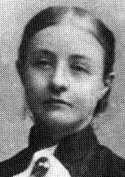Harriette Colenso
| Harriette Emily Colenso | |
|---|---|
 | |
| Born |
30 June 1847 Tharston, Norfolk, England |
| Died | 2 June 1932 (aged 84) |
| Residence |
|
| Nationality | British |
| Other names | Udhlwedhlwe |
| Occupation | Missionary |
| Years active | 1862–1913[1] |
| Parent(s) | John Colenso |
Harriette Emily Colenso (30 June 1847 – 2 June 1932) was a British Christian missionary in southern Africa. She was the eldest of five daughters of John Colenso, the Bishop of Natal, and continued his work, interceding on behalf of the Zulu before the British Government. She made representations to the Crown on behalf of Dinuzulu and his uncles, in exile on St Helena from 1890 to 1897.
Early life
Harriette Emily Colenso was born in Tharston, Norfolk, England, in 1847.[2] She was the eldest of the five daughters of John Colenso, who would become the Bishop of Natal.[3] As a child in Natal, she was nicknamed Udhlwedhlwe, which translates to Walking Stick, signifying her role as support and guide to her father.[4]
Work
During the trial of Langalibalele in 1874–5, in which her father was defending the accused, Miss Colenso served as secretary to her father.[4]
After the death of her father in 1883, she pursued his two main aims in Natal, namely the continuation of the Church of England in Natal, and defending the rights of the native population of Natal and Zululand.[4]
Colenso fought against the attitudes of those, such as Sir Theophilus Shepstone, whose policy it was to undermine the Zulu royal family, granting minor chiefs their own chiefdoms, and to foster intertribal strife.[5]
She advised Dinuzulu to give himself up to the British authorities in 1888.[6] For his defence she obtained the services of leading counsel Harry Escombe and she herself worked hard in his defence.[7] She convinced Sir Marshal Clarke, Resident Commissioner in Zululand from 1893 to 1897, of her point of view and he in turn persuaded London that Dinuzulu be permitted to return from exile in St Helena and be given the position of induna and confidant of the Government.[7] Colenso, however, made the error in 1894 of supporting the annexation of Zululand by Natal in return for Dinuzulu's release.[7]
Colenso's influence amongst native leaders can be seen in her discussion with Martin Lutuli and Saul Msane in 1900 regarding the formation of the Natal Native Congress, a precursor of the African National Congress.[8]
After the troubles in Zululand of 1906–7, Colenso once again advised Dinuzulu to surrender to the authorities in Natal.[6] Again she came to his defence, obtaining W. P. Schreiner as his counsel, and financially ruining herself in the process, despite a grant for his defence of £2,100 from the Imperial Government.[7] Her evidence and that of the Natal Native Affairs Commission of 1906–7 led the Colonial Office to insist on a fair trial for Dinuzulu, with an impartial Judge President from outside Natal.[7]
After the creation of the Union of South Africa in 1910, Louis Botha's Government released Dinuzulu, at least in part as a result of Colenso's intermediation.[7]
Colenso's efforts to sustain the Church of England in Natal failed with the passing of the South African Church Properties Act in 1910, which reintegrated Church of England lands into the Church of the Province of South Africa. Both she and her sister Agnes lost their home in Bishopstowe and were relocated to Pietermaritzburg.[9]
After Dinuzulu's death in 1913, Colenso became much less active. Her influence was waning. In her sixties, the issues affecting native people had changed to those of industrialisation and urbanisation. Her appeals to the British Government were of lesser impact after the granting of autonomy to the Union of South Africa. She was also burdened with debt.[10]
Death and legacy
Harriette Colenso died on 2 June 1932.[2] Alice Werner dedicated her work of 1933, Myths and Legends of the Bantu, to Harriette Colenso and her sister Agnes Mary Colenso.[11]
References
- ↑ Marks 1963.
- 1 2 "Colenso, Harriette Emily". Oxford Dictionary of National Biography (online ed.). Oxford University Press. doi:10.1093/ref:odnb/5874. (Subscription or UK public library membership required.)
- ↑ Marks 1963, p. 403.
- 1 2 3 Marks 1963, p. 404.
- ↑ Marks 1963, pp. 406–407.
- 1 2 Marks 1963, p. 407.
- 1 2 3 4 5 6 Marks 1963, p. 408.
- ↑ Marks 1963, pp. 409–410.
- ↑ Marks 1963, p. 405.
- ↑ Marks 1963, p. 411.
- ↑ T. C. Y. (June 1934). "Reviewed Work: Myths and Legends of the Bantu by Alice Werner". Folklore. 45 (2): 182–184. JSTOR 1256086.
Bibliography
- Colenso, H. E. (1895), Zululand, the Exiled Chiefs, Natal, and the Colonial Office: 1893–5, London, JSTOR 60229994
- Guy, Jeff (2001). The view across the river : Harriette Colenso and the Zulu struggle against imperialism. Oxford: James Currey. OCLC 777867225.
- Marks, Shula (1963). "Harriette Colenso and the Zulus, 1874-1913". The Journal of African History. 4 (3): 403–411. JSTOR 180031. doi:10.1017/s0021853700004321.
- "Miss Harriette Colenso". Journal of the Royal African Society. 31 (124): 341. July 1932. JSTOR 716769.